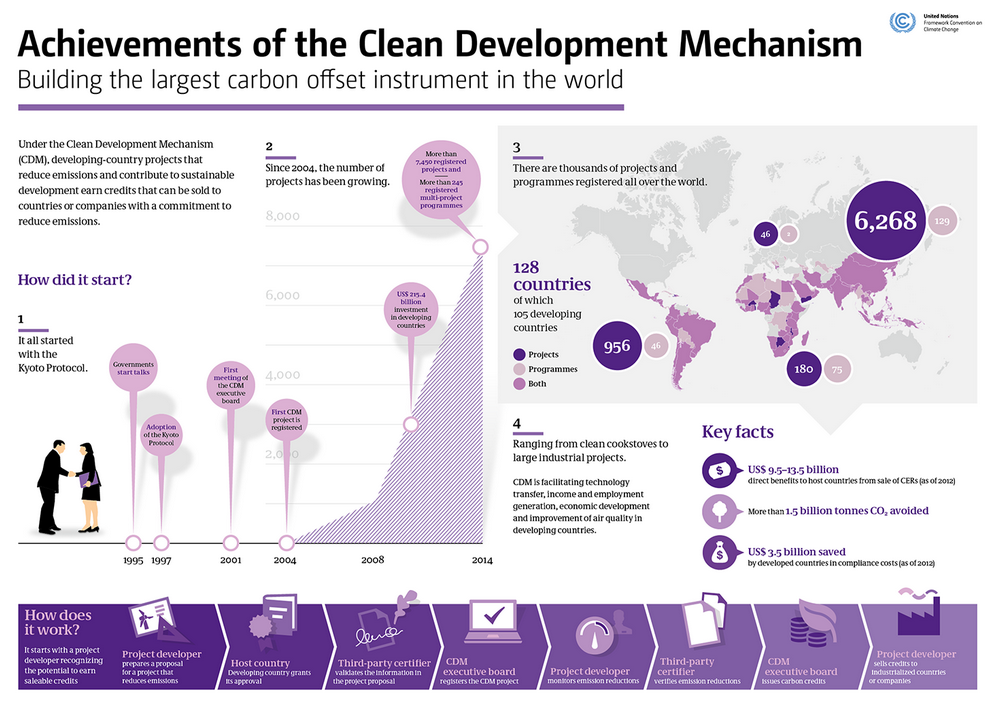On April 23, 2014, the UN Framework Convention on Climate Change (UNFCCC) published a report titled “Options for possible additional land use, land-use change and forestry activities and alternative approaches to addressing the risk of non-permanence under the clean development mechanism.” “Non-permanence” according to the UNFCCC, refers to the temporary nature of the removals, given that carbon contained in the biomass of trees is at a continuous risk of being emitted into the atmosphere.” This occurs when carbon stocks accumulated and certified under a LULUCF project activity are released back into the atmosphere. This can be caused by either common natural hazards (unintentional reversal) or a decision by the project participants (intentional reversal). Normal fluctuations in “carbon stocks from natural hazards (e.g. fires and pests) or management actions (e.g. selective logging) that do not decrease the carbon stocks below the minimum level required for CERs do not qualify as reversals.”

The report took into consideration seventeen submissions from: 1) Parties and group of Parties to the Kyoto Protocol, 2) international organizations (IGOs) and 3) non-governmental organizations (NGOs).
The scope of the paper explores:
1. Options for additional land use, land use change and forestry (LULUCF) activities and their implications for the validation, monitoring and verification under the clean development mechanism (CDM).
*Note: CDM is a mechanism established under the Kyoto Protocol, which provides for emissions reduction projects that generate Certified Emission Reduction (CER) units, which can be traded under emission trading schemes. In a nutshell, CDM is a mechanism for financing emissions abatement programs.

Some general views expressed through the submissions include:
- 3 groups of Parties and 6 Parties recognized the need to expand the LULUCF activities included under the CDM.
- 1 group of Parties and 3 Parties expressed favor and interest in engaging in open discussion to this possibility.
- 1 IGO and 1 NGO recognized the need to expand.
- 1 group of Parties expressed disinterest to engage in expansion, but open to leaving discussions open for other Parties.
- 3 NGOs expressed in a joint submission that they are not in favor of expanding LULUCF activities under the CDM.
- 2 groups of Parties and several Parties “expressed the view that the land sector is very significant for climate change mitigation and sustainable development and … CDM as a flexible mechanism holds a lot of potential [to incentivize].” This group highlighted the restrictive nature of CDM only recognizing afforestation and deforestation under the CDM. They suggested the inclusion of additional LULUCF activities could create opportunities for new mitigation projects.
- Some suggested additions to the CDM of LULUCF activities include (mostly drawn from Article 3, Paragraph 4 of the Kyoto Protocol):
- Forest management
- Revegetation
- Cropland management
- Grazing land management
- Wetland drainage and rewetting
- Agroforestry
- Silvipastoral systems
- Crop production and rangeland management
- Avoided drainage and rewetting of peatland
- Some suggested additions to the CDM of LULUCF activities include (mostly drawn from Article 3, Paragraph 4 of the Kyoto Protocol):
* For a full list, see the report.
2. Options for alternative approaches for addressing non-permanence in LULUCF activities and their implications on validation, monitoring and verification under CDM. The options suggested through the submissions included:
- Permanence buffer backed up by host Party guarantee. The suggestion is to set aside a percentage (determined based on the risk of the project) of CERs issued for a LULUCF project as a permanence buffer of credits at the time of issuance. In the event of permanence, these buffer credits can be used to replace the CERs affected by the reversal. Liability would be held by the host Party or an entity designated by the host Party. Upon completion of the project, permanence buffer can be retained permanently or could be returned to project participants once all credits issued to a project activity are fulfilled
- Tonne-year-based crediting. “Credits are issued after permanence is achieved, based on a mathematical product of tonnes of carbon dioxide equivalent and years of resident of the carbon in the carbon pools.” Option credits would be issued after permanence is achieved and there is no more threat of reversal.
The restrictive nature of programs that qualify under CDM is one of the biggest barriers facing change in the land sector, one that our Agriculture and Forestry sector paper highlights. The recent report issued by the UNFCCC is promising and a step in the right direction. In addition to innovating new strategies to combat greenhouse gas emissions from the land sector, we must work to improve our existing strategies and mechanisms.
